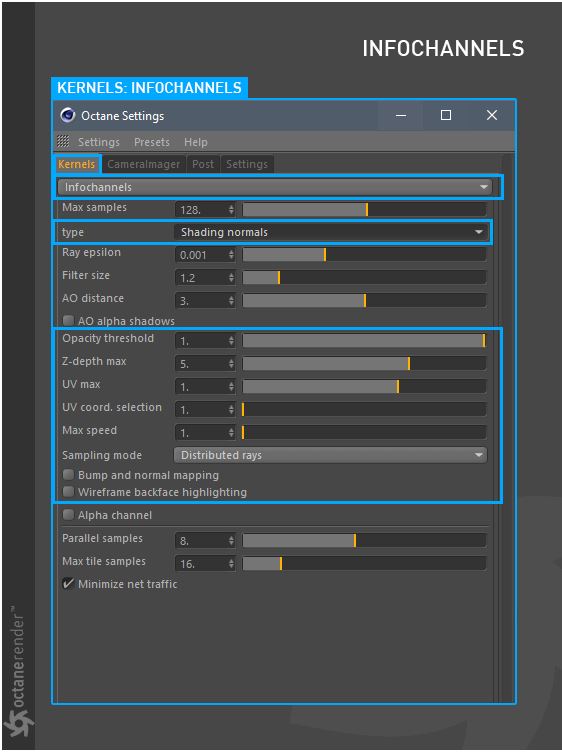
The Info Channel kernel evaluates scene data and renders the data as color images that can be used in post processes for compositing. Figure 1 shows the Info channel settings in the KernelsBy definition, this is the central or most important part of something. In Octane, the Kernels are the heart of the render engine. settings tab.

Figure 1: The PMC settings in the Kernels tab.
Maximum Samples
sets the maximum number of samples per pixel before the rendering process stops. The higher the number of samples per pixel, the cleaner the render. There is no rule as to how many samples per pixel are required for a good render, it is subjective and may vary depending on the content and complexity of the scene being rendered.
Type
This parameter specifies the various passes that can be rendered and used in the compositing process (figure 2).

Figure 2: The list of Info Channels that can be generated.
Ray Epsilon
Is the distance between the geometry and the light ray when calculating ray intersections for lighting and shadowing. Larger values push rays away from the geometry surface. Lower values are more accurate, but can cause artifacts on large or distant objects. Ray Epsilon is similar to raytracing bias in other rendering engines. Adjust Ray Epsilon to reduce artifacts in large scale scenes.
Filter Size
Sets the filter size in terms of pixels. This can improve aliasing artifacts in the render. However, if the filter is set too high, the image can become blurry.
AO Distance
Allows any object with transparency (specular materials, materials with opacity settings and alpha channels) to cast a shadow accordingly instead of behaving as a solid object.
AO Alpha Shadows
Takes the opacity of the surface as determined by its shader in to account when rendering using the Ambient Occlusion info channel. Ambient Occlusion shading is based on the opacity of the surface.
Opacity Threshold
If there is an opacity value specified in a material, opacity value can be increased or decreased with this option. It only changes the opacity value for the infochannel output. The opacity value in your material does not change. This option does not work if the opacity value in the material is opaque.
Z-DepthA measure of object distances from the camera typically represented as a grayscale image. Max
Determines the maximum depth as shown in the shading of the Z-depth info channel pass.
UV Max
Sets the maximum value that can be shown for the texture coordinates.
UV Coord. Selection
Determines which set of UV coordinates to use.
Max Speed
Speed mapped to the maximum intensity in the motion vector channel. A value of 1 means a maximum movement of 1 screen width in the shutter interval.
This option has three sub-menus:
Bump and Normal Mapping
If bump or normal map channels are used with scene materials, this option determines whether they appear in the info channel rendering.
Wireframe Backface Highlighting
Highlights the back face of the wireframe output. The Wireframe info channel needs to be selected for this feature to be active.
This option removes background images or colors created by the SunSky environment node from the rendered image while not affecting any lighting cast by the environment. This can be useful if the user wants to composite the render over another image and does not want the background to be present. Note that objects appearing in the RGB channels will have a bleeding edge which may appear as noise artifacts however these edges are not included in the alpha channel itself.
Parallel Samples
Controls how many samples are calculated in parallel. Smaller values require less memory to store the samples state but may cause the render to be a bit slower. High values require more memory but can reduce render time. The change in performance depends on the scene and the GPUThe GPU is responsible for displaying graphical elements on a computer display. The GPU plays a key role in the Octane rendering process as the CUDA cores are utilized during the rendering process. architecture.
Maximum Tile Samples
Controls the number of samples per pixel that Octane will render before storing the result in the render buffer. A higher number means that results arrive less often in the film buffer.
Minimize Net Traffic
Distributes only the same tile to the net render slaves until the max samples/pixel has been reached for that tile and only then will the next tile is distributed to slaves when enabled. Work done by local GPUs is not affected by this option. This way a slave can merge all its results into the same cached tile until the master switches to a different tile.